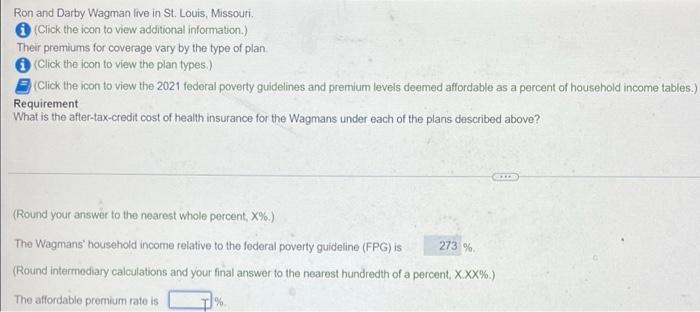Ron and Darby Wagman live in St. Louis, Missouri. (Click the icon to view additional information.) Their premiums for coverage vary by the type of plan (Click the icon to view the plan types.) (Click the icon to view the 2021 federal poverty guidelines and premium levels deemed affordable as a percent of household income tables.) Requirement What is the after-tax-credit cost of health insurance for the Wagmans under each of the plans described above? (Round your answer to the nearest whole percent, X%.) 273 %. The Wagmans' household income relative to the federal poverty guideline (FPG) is (Round intermediary calculations and your final answer to the nearest hundredth of a percent, X.XX%.) The affordable premium rate is %. Ron and Darby are each 30 years old, neither smokes, and they have no children or other dependents. Ron is attending law school full time and working part time (2021 earnings = $9,500). Darby works full time (2021 earnings = $37,600). Their 2021 household income is more than 250% of the FPG (but not more than 300% of the FPG). Darby's employer does not offer employee health insurance coverage. The Wagmans choose to purchase insurance through the federal exchange operating in Missouri. They are credit eligible for all 12 months in 2021. a. Under a Gold plan, monthly premiums are $630 (covers 2) per month, so the annual cost of coverage is $7,560. b. The second-least-expensive Silver plan (the benchmark plan) involves premiums of $475 per month (covers 2), or $5,700 per year. c. Under a Bronze plan, monthly premiums are $386 (covers 2) per month, so the annual cost of coverage is $4,632. a. Under a Gold plan, monthly premiums are $630 (covers 2) per month, so the annual cost of coverage is $7,560. b. The second-least-expensive Silver plan (the benchmark plan) involves premiums of $475 per month (covers 2), or $5,700 per year. c. Under a Bronze plan, monthly premiums are $386 (covers 2) per month, so the annual cost of coverage is $4,632. Ron and Darby Wagman live in St. Louis, Missouri. (Click the icon to view additional information.) Their premiums for coverage vary by the type of plan (Click the icon to view the plan types.) (Click the icon to view the 2021 federal poverty guidelines and premium levels deemed affordable as a percent of household income tables.) Requirement What is the after-tax-credit cost of health insurance for the Wagmans under each of the plans described above? (Round your answer to the nearest whole percent, X%.) 273 %. The Wagmans' household income relative to the federal poverty guideline (FPG) is (Round intermediary calculations and your final answer to the nearest hundredth of a percent, X.XX%.) The affordable premium rate is %. Ron and Darby are each 30 years old, neither smokes, and they have no children or other dependents. Ron is attending law school full time and working part time (2021 earnings = $9,500). Darby works full time (2021 earnings = $37,600). Their 2021 household income is more than 250% of the FPG (but not more than 300% of the FPG). Darby's employer does not offer employee health insurance coverage. The Wagmans choose to purchase insurance through the federal exchange operating in Missouri. They are credit eligible for all 12 months in 2021. a. Under a Gold plan, monthly premiums are $630 (covers 2) per month, so the annual cost of coverage is $7,560. b. The second-least-expensive Silver plan (the benchmark plan) involves premiums of $475 per month (covers 2), or $5,700 per year. c. Under a Bronze plan, monthly premiums are $386 (covers 2) per month, so the annual cost of coverage is $4,632. a. Under a Gold plan, monthly premiums are $630 (covers 2) per month, so the annual cost of coverage is $7,560. b. The second-least-expensive Silver plan (the benchmark plan) involves premiums of $475 per month (covers 2), or $5,700 per year. c. Under a Bronze plan, monthly premiums are $386 (covers 2) per month, so the annual cost of coverage is $4,632










